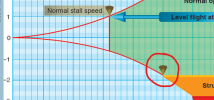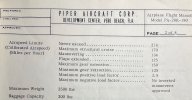My plane has a placard on the panel stating "Rough Air or Maneuvering Speed 125MPH (109KTS)". This always seemed oddly slow to me, but I don't fly at maneuvering speed much, so I didn't think too much about it. Studying for the commercial (and having a couple hairy weather experiences) has led me to think more about Va and when it might be appropriate to slow down to reduce stress on the aircraft. I was discussing this with another POA pilot, who agreed that it seemed strangely slow, and questioned if the POH might give a range based on weight.
My POH, VB-750, issued August 1, 1975, states in the limitations section "Design Maneuvering Speed 125MPH (109KTS)". That's it. It also calls out the placard mentioned above as being a required marking.
So I dug a little deeper and found VB-840, published August 20, 1976, which is another POH for a PA32R-300. FWIW, my plane is a 1976 model (#169), and AKAIK there were no changes in the PA32R-300 airframe through its production run. Anyway, VB-840 states in section 2 that Va is 132 KIAS at max gross (3600lb) and 100 KIAS at 2170 lb. Empty weight of my plane is 2103 lbs.
It looks to me like they picked 109KTS as the Va at the lightest weight the plane would reasonably be flown at. Now, I know the POH that came with my airplane controls its aerodynamics , but it's nice to have some more realistic numbers. I don't understand why they didn't bother to put that in the earlier book.
, but it's nice to have some more realistic numbers. I don't understand why they didn't bother to put that in the earlier book.
My POH, VB-750, issued August 1, 1975, states in the limitations section "Design Maneuvering Speed 125MPH (109KTS)". That's it. It also calls out the placard mentioned above as being a required marking.
So I dug a little deeper and found VB-840, published August 20, 1976, which is another POH for a PA32R-300. FWIW, my plane is a 1976 model (#169), and AKAIK there were no changes in the PA32R-300 airframe through its production run. Anyway, VB-840 states in section 2 that Va is 132 KIAS at max gross (3600lb) and 100 KIAS at 2170 lb. Empty weight of my plane is 2103 lbs.
It looks to me like they picked 109KTS as the Va at the lightest weight the plane would reasonably be flown at. Now, I know the POH that came with my airplane controls its aerodynamics
 , but it's nice to have some more realistic numbers. I don't understand why they didn't bother to put that in the earlier book.
, but it's nice to have some more realistic numbers. I don't understand why they didn't bother to put that in the earlier book.




